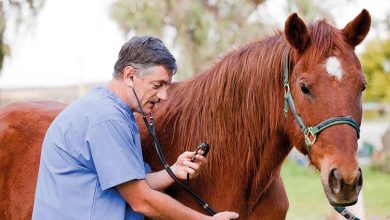A Guide to English and Western Horse Tack

Whether you are an experienced equestrian or heading to your first riding lesson, the sheer variety of horse tack and equipment can be overwhelming. The most common division is between English and Western tack. English tack is often plainer in style and more classical in design, and Western tack is usually showier, incorporating silver and other eye-catching details.
Halters and Lead Ropes
The most basic of equine equipment is the halter, required to move the animal around safely. Keep in mind that different halters are best suited for different tasks. Nylon halters are strong, cheap, and can be found in endless colors. However, they are not safe for a horse to wear unattended, unless they have a breakaway crown in case the horse gets caught on something. Leather halters have classic style and beauty, but do require regular cleaning and conditioning to prevent them from becoming brittle and dangerous. Be sure to have a strong lead rope on hand for everybody’s safety.
Bridles and Reins
In its simplest form, a bridle is a noseband or bit, attached to the horse, with reins for control by the rider. Today, they come in numerous styles and in any color of the rainbow.
An English bridle is often more complicated than a Western bridle, also known as a headstall, and is designed to stay on if the horse gets caught by a branch or other hazard. The snaffle bit, or English bit, is the basis of English riding. A snaffle bridle contains a headstall and a cavesson, or noseband, as well as a throatlatch, which fastens under the jaw, and reins that are buckled together at the ends. There are several variations by sport, as advanced dressage horses may go in a double bridle, containing both a curb and snaffle bit and allowing the rider to give much more subtle cues.
Western bridles often consist of a simple headstall or a split ear design, and may include a curb chain or strap and a throatlatch. The curb bit is often referred to as a western bit and western reins are usually much longer, and may not be attached at the ends.
Saddles and Saddle Pads
There are many differences between English and Western saddles, but they serve the same purpose, to protect the horses back and offer support to the rider. Saddle designs and fit vary greatly, and it is wise to consult a saddle fitter before investing in a new saddle.
English saddles are usually lighter than Western saddles. Additionally, they lack a horn, encouraging the rider to rely more on balance and core strength. The most common variation in English saddles is the position of the knee flap. Dressage saddles have a longer flap, while jumping and cross-country saddles feature a shorter, more forward flap, designed to support riding with a shorter stirrup.
Western saddles feature the signature horn, as well as a larger base, designed for all day riding. Most new riders feel more secure in a western saddle, so they are popular with trail riding camps and beginner lessons. Western saddles often have rings for attaching saddle bags to for long distance riding or camping as well.
Bareback pads are another option. However, they do not protect the horse’s back from an unbalanced seat. Bareback pads are best used to protect a rider from a horse with high withers or an otherwise uncomfortable back.
The most noticeable difference between English saddle pads and Western saddle pads is the difference in thickness. Western saddle pads are often much thicker and may be a solid pad or a traditional folded blanket, while English saddle pads are lighter weight and often shaped to fit the saddle.
Stirrups and Girths
English and Western stirrups are also noticeably different. Western stirrups are attached to the saddle by broad, permanent leather fenders, providing great stability to the leg, but not much in the way of adjustment. On the other hand, English stirrups are connected by removable stirrup leathers and can be adjusted from jockey length to the long stirrups typically seen in dressage and any point in between.
The girths or cinches used to secure the saddle to the horse also differ greatly. Western saddles may have one or two cinches, the front used to secure the saddle and the back adding additional stability, especially in high speed roping events. The front cinch is often fleece or mohair lined and secured to the saddle by leather or nylon tie straps on either side.
English saddles have built in billets on each side and these are buckled to a traditionally leather girth. Jumping type saddles have shorter billets than dressage saddles, and may incorporate elastic into the girth to allow the horse more freedom of movement. English girths may be lined or covered with sheepskin or fleece to prevent rubbing.
Additional Tack
In addition to a saddle and bridle, depending on your riding discipline, you may require other equipment. Breast collars and breast plates are used to keep the saddle in place over rough terrain or while jumping. However, they are not a replacement for proper saddle fit. Martingales and tie downs are used to prevent a horse from throwing his or her head and to help a rider maintain control. These tools are best used under supervision of a professional as, when used incorrectly, they can cause further issues or even injury. Providing added protection are horse boots, sport boots and bell boots, helping to prevent overreach and other accidental injury. Additionally, ice boots aid in reducing swelling and improving recovery time.
Other Stable Supplies
Other horse supplies you may use include first aid supplies, horse blankets, and training equipment. Turnout blankets and sheets are used to keep horses warm and dry in inclement weather. Stable blankets are used to keep horses warm inside their stalls in especially cold weather. Fly sheets and fly masks are used in conjunction with fly spray to protect from insect bites and are a vital part of horse care. A well stocked grooming tote usually includes shampoo, conditioner, an assortment of brushes, hoof picks, soft cloths, and possibly clippers. Stalled horses are prone to boredom and unwanted behaviors such as cribbing, so you may need to invest in salt licks and horse toys. Other training equipment can include lunge lines and surcingles, which are used when training on the lunge line or to drive. You may also use crops or spurs and spur straps. If you plan to show, you may need additional saddlery, such as show halters, fancy lead ropes and extra grooming supplies.
You will need supplies for yourself as well. Depending on your climate, you may need mud or paddock boots. Riding clothes, including breeches, jeans, long sleeved shirts, waterproof outerwear and protective vests will come in handy. Most importantly, you will need a well fitting helmet. Always replace your helmet after an accident or when the warranty runs out.
You need many things to care for your equine friend. However, you can find everything you need at our online store as well as 10% off your first order, a $10 credit, and free shipping on orders over $75.




